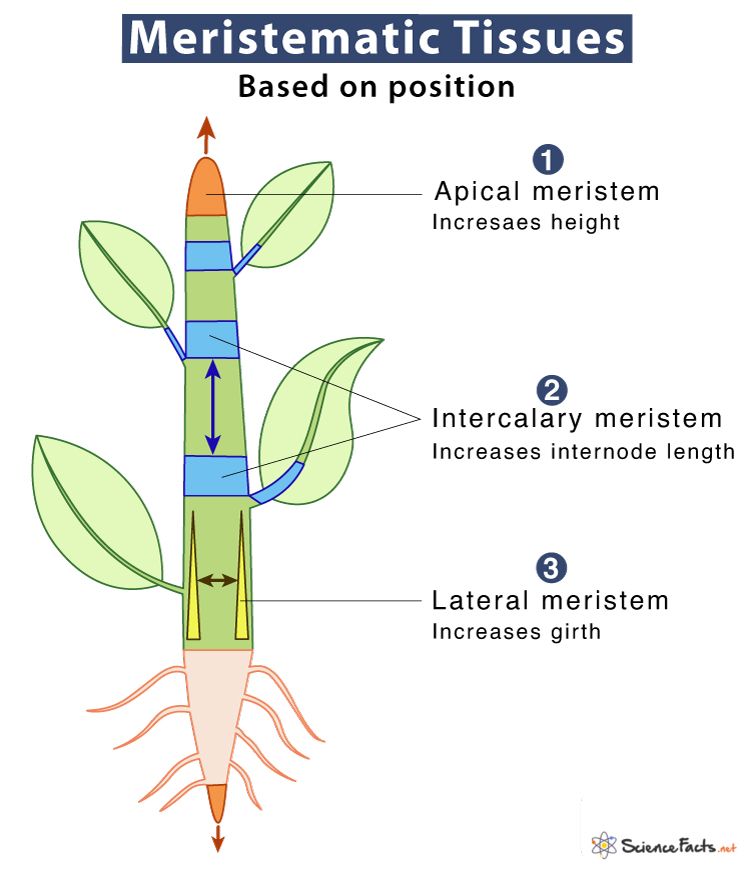Meristematic Tissue
Meristematic tissue, commonly called meristem, is a group of undifferentiated cells that remain young and divide indefinitely throughout plant life. Cells in the meristem can develop into any tissues and organs in plants.
Thus, meristems are the region of active growth in plants. They are mainly found in the shoot and root apices that give rise to new organs and allow plants to grow and repair worn-out tissues.
In 1858, Carl Wilhelm von Nägeli coined the term ‘meristem’. The term ‘meristem’ originated from the Greek word ‘merizein’, meaning ‘to divide.’
Characteristics of Meristematic Tissue in Plants
Meristems have some unique characteristics. They are:
- Can self-renew and self-sustain indefinitely. When meristems divide by mitosis, the cell that remains in the meristem is called an initial, and the other is the derivative. As new cells add up by repeated divisions of the initial cells, the derivative cells gets pushed away from the zone of active division. As they mature, the derivatives differentiate into other types of tissues.
- They are small and cuboidal in shape.
- Have a single, large, and prominent nucleus
- Contain small vacuoles, thin cell walls, and dense cytoplasm.
- Have a high metabolic rate.
- Cannot store food
Functions of Meristematic Tissue
The three main roles they perform in plants are:
- Allowing plants to grow vertically in length
- Allowing plants to grow in diameter, increasing the girth of the plant
- Repairing and regenerating damaged parts
Types of Meristematic Tissue with Functions
It is divided into three main types based on their occurrence in plants. They are:
1. Apical Meristem
This meristem is located at the tip of the root and stem. The cells produced by divisions in the apical meristem are divided into two types. The promeristem zone contains actively dividing cells (apical initials), and the meristematic zone consists of protoderm, procambium, and ground meristem.
It is responsible for the primary growth of plants. It allows the plant to grow vertically in height, both above and below the ground, by extending the root and shoot tip.
2. Intercalary Meristem
It is found at the internodes or stem regions between the places where leaves attach. The intercalary meristem is seen in monocotyledonous plants, such as grass and pine.
It also adds to the height of plants by increasing the length of the internode.
3. Lateral Meristem
This type of meristem is present on the lateral side of the stem and root of a plant.
It increases the girth and thickness of the plant.
The two types of lateral meristems are:
- Vascular Cambium: Plants that grow in diameter add new tissues laterally in the form of cylinder called vascular cambium. It extends throughout the plant length from the shoot tip to the root tip. Tissues formed by division of vascular cambium are secondary tissues. Vascular cambium is mainly found in perennial plants and rarely in annual plants.
- Cork Cambium: Also called phellogens, are found in the bark of roots and stems of woody plants, producing the cork cells. They form under the epidermis and are long cylinders parallel to the vascular cambium. In other species, disk-like cork cambia produce flat pieces of bark tissues that fall off as the tree becomes old.
Difference between Meristematic Tissue and Permanent Tissue
| Features | Meristematic Tissue | Permanent Tissue |
|---|---|---|
| 1. Ability to divide | Can divide | Cannot divide |
| 2. Cell Composition | It consists of undifferentiated cells | It consists of differentiated cells |
| 3. Tissue Type | Simple | Simple or complex |
| 4. Nature of Cells | Living | May be living or non-living |
| 5. Cytoplasm | Contain dense cytoplasm | It may or may not contain cytoplasm |
| 6. Nucleus | All cells have a prominent nucleus | Some cells have a prominent nucleus, while some do not have any nucleus |
| 7. Size and Shape of Cells | Small and isodiametric | Large and varied shape |
| 8. Arrangement of Cells | Compactly arranged, with no intercellular space | Loosely or compactly arranged, based on cell division |
| 9. Presence or Absence of Vacuoles | Usually absent | Present only in living cells |
| 10. Cell Division | Occurs rapidly | No division |
| 11. Metabolic Rate | Very high | Very low or non-existent |
-
References
Article was last reviewed on Thursday, February 2, 2023




